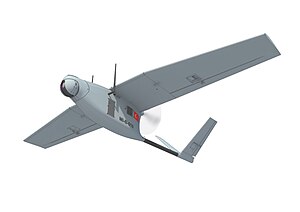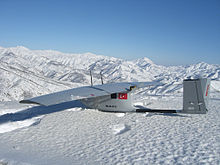
An unmanned combat aerial vehicle (UCAV), also known as a combat drone, fighter drone or battlefield UAV, is an unmanned aerial vehicle (UAV) that is used for intelligence, surveillance, target acquisition, and reconnaissance and carries aircraft ordnance such as missiles, anti-tank guided missiles (ATGMs), and/or bombs in hardpoints for drone strikes. These drones are usually under real-time human control, with varying levels of autonomy. UCAVs are used for reconnaissance, attacking targets and returning to base; unlike kamikaze drones which are only made to explode on impact, or surveillance drones which are only for gathering intelligence.

The AeroVironment RQ-11 Raven is a small hand-launched remote-controlled unmanned aerial vehicle developed for the United States military, but now adopted by the military forces of many other countries.

The TAI Anka is a family of unmanned aerial vehicles developed by Turkish Aerospace Industries primarily for the Turkish Air Force. Envisioned in the early 2000s for aerial surveillance and reconnaissance missions, Anka has evolved into a modular platform with synthetic-aperture radar, precise weapons and satellite communication.

The Elbit Systems Skylark I and Skylark II are miniature UAVs developed by Elbit Systems. Initial models of the Skylark entered service in 2008.

The IAI Eitan is an unmanned reconnaissance aircraft developed in Israel in the early 21st century by the Malat division of Israel Aerospace Industries. The aircraft is a newer version of the IAI Heron. Along with intelligence, surveillance, target acquisition, and reconnaissance (ISTR), Israeli IAI Eitan also capable of holding armed roles. There are conflicting reports on whether the exported Eitan's are unarmed or armed.

The Vestel Karayel is a surveillance, reconnaissance and later combat unmanned aerial vehicle system developed by Vestel Savunma later the company renamed as Lentatek. The drone is currently operated by Turkish Armed Forces and the Armed Forces of Saudi Arabia.

The Black Hornet Nano is a military micro unmanned aerial vehicle (UAV) developed by Prox Dynamics AS of Norway, and in use by the armed forces of Norway, the United States, France, the United Kingdom, Germany, Denmark, Algeria, Ireland, Australia, the Netherlands, Poland, New Zealand, India, Turkey, South Africa, Ukraine and Morocco.
The Bayraktar UAV or Bayraktar UCAV is a family of unmanned aerial vehicles designed and manufactured by Turkish company Baykar. The UAVs were developed for the Turkish Armed Forces from 2004 until the present. Some models are designed for surveillance and reconnaissance only, others are capable of tactical ground-strike missions. Baykar is also developing drones to counter other aerial systems. The word bayraktar means flag-bearer in Turkish.

TCG Anadolu (L-400) is an amphibious assault ship of the Turkish Navy. It is named after the peninsula of Anatolia which forms the majority of the land mass of Turkey. The construction works began on 30 April 2016 at the shipyard of Sedef Shipbuilding Inc. in Istanbul, with the keel being laid on 7 February 2018. TCG Anadolu was commissioned with a ceremony on 10 April 2023.

Baykar is a private Turkish defence company specialising in UAVs, C4I and artificial intelligence.

Bayraktar Akıncı is a high-altitude long-endurance (HALE) unmanned combat aerial vehicle (UCAV) being manufactured by the Turkish defence company Baykar. The first three units entered service with the Turkish Armed Forces on 29 August 2021.

The TAI Aksungur is an unmanned combat aerial vehicle (UCAV) built by Turkish Aerospace Industries (TAI) for the Turkish Armed Forces. Using existing technology from the TAI Anka series of drones, it is the manufacturer's largest drone with payload capacity for mission-specific equipment. It is intended to be used for long-term surveillance, signals intelligence, maritime patrol missions, or as an unmanned combat aerial vehicle. TAI planned to integrate weapon packages and put the Aksungur into production in early 2020. The first unit was delivered to the Turkish Naval Forces on 20 October 2021.

The Bayraktar TB2 is a medium-altitude long-endurance (MALE) unmanned combat aerial vehicle (UCAV) capable of remotely controlled or autonomous flight operations. It is manufactured by the Turkish company Baykar Makina Sanayi ve Ticaret A.Ş., primarily for the Turkish Armed Forces. The aircraft are monitored and controlled by an aircrew in a ground control station, including weapons employment. The development of the UAV has been largely credited to Selçuk Bayraktar, a former MIT graduate student.

Mini Akıllı Mühimmat (MAM), meaning "smart micro munition" is a family of laser-guided and/or GPS/INS guided bombs produced by Turkish defence industry manufacturer Roketsan.

An unmanned surveillance and reconnaissance aerial vehicle, is an unarmed military UAV that is used for intelligence, surveillance, target acquisition, and reconnaissance (ISTAR). Unlike unmanned combat aerial vehicle (UCAV), this type of system is not designed to carry aircraft ordnance such as missiles, ATGMs, or bombs for drone strikes. The main purpose is to provide battlefield intelligence. Small sized short-range man-portable unmanned aerial vehicles are called miniature UAV also used for battlefield intelligence.

Selçuk Bayraktar is a Turkish pilot, engineer and businessman. He is the chairman of the board and the chief technology officer of the Turkish technology company Baykar. He is also known as the architect of Turkey's first indigenous unmanned combat aerial vehicle (UCAV) Bayraktar TB2 and first unmanned fighter jet Bayraktar Kızılelma. Bayraktar is also the founding chairman of the Turkish Technology Team Foundation.

Haluk Bayraktar is a Turkish engineer and executive. He is the CEO of Baykar, TUBITAK Board Member and founder and chairman of the board of Turkey Technology Team Foundation and SAHA Istanbul. He is a pioneer of Turkey for autonomous technology efforts which reshaped battlefields and geopolitics which resulted with a change of future warfare doctrines.

The Bayraktar Kızılelma is a single-engine, low-observable, carrier-capable, jet-powered unmanned combat aerial vehicle (UCAV), currently in development by Turkish defense company Baykar. The aircraft is being developed as part of Project MIUS. The initial Bayraktar Kızılelma (Kızılelma-A) is subsonic. Planned variants are intended to be supersonic, the latter having a twin-engined configuration. It is one of the two Turkish jet-powered stealth UCAV along with TAI Anka-3.

The Baykar Bayraktar TB3 is a Turkish medium-altitude long-endurance (MALE) unmanned combat aerial vehicle (UCAV) capable of short-range landing and take-off, produced by Baykar. According to the initial plans, the ship TCG Anadolu was expected to be equipped with Lockheed Martin F-35B Lightning II fighter jets but the vessel entered a modification process to allow it to be able to accommodate UAVs such as Bayraktar TB3 following the removal of Turkey from the F-35 procurement program.





















